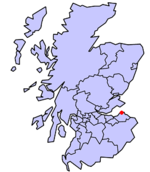Lamb (island)
Islands of the ForthLandforms of East LothianLothians geography stubsMicronations in ScotlandNorth Berwick ... and 1 more
Uninhabited islands of Scotland

Lamb, sometimes called Lamb Island or The Lamb, is a small uninhabited island measuring approximately 100 by 50 metres (330 ft × 160 ft), between the islands of Fidra and Craigleith in the Firth of Forth, off the east coast of Scotland. The Lamb is flanked by two "sheep dogs", North and South Dog Islands, which are basically small skerries. Like the other Islands of the Forth off North Berwick, the Lamb is a result of volcanic activity millions of years ago.
Excerpt from the Wikipedia article Lamb (island) (License: CC BY-SA 3.0, Authors, Images).Lamb (island)
Geographical coordinates (GPS) Nearby PlacesShow on map
Geographical coordinates (GPS)
| Latitude | Longitude |
|---|---|
| N 56.069 ° | E -2.748 ° |








